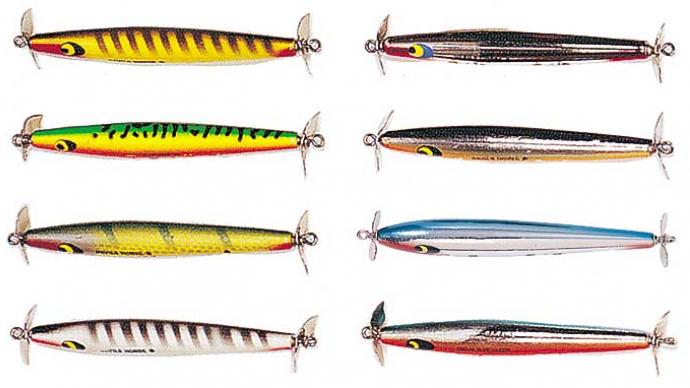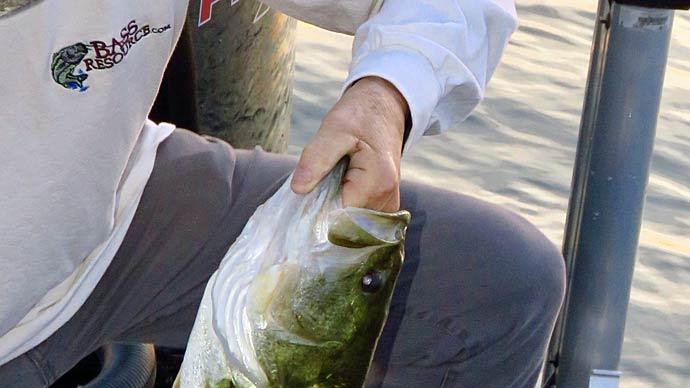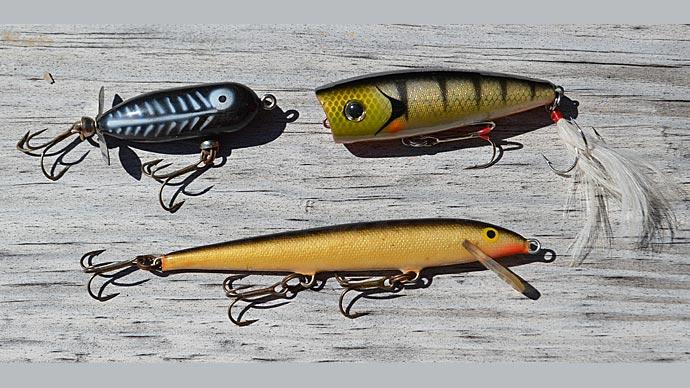
In terms of modifications to his Devil’s Horse topwaters, Barry Weaver does very little. He adds an oval split-ring to the nose of the bait, because the knot will not slip into the groove, as is often the case with round split-rings.
True to the original design, the modern Devil Horse does not use round eyelets to hold the treble hooks, but instead uses metal hook hangers stamped from sheet metal and held in place by two small screws. Some anglers believe this restricts the treble hooks flexibility and causes a big bass to get too much leverage on the bait, allowing the Devil’s Horse to be thrown from the bass’s mouth. To remedy this, they add split-rings between the hook hanger and the treble hook to reduce the leverage advantage the original design gave the bass.
Barry has always felt this concern was without merit. Countless bass have fallen to his Devil’s Horses fished just as they came right out of the package. He doesn’t even replace the hooks until absolutely necessary.
Swapping Out the Trebles

“I’ll swap the trebles out after a few months of fishing because they will rust. If you get a lot of strikes and a lot of hang ups, you will crack the anodized coating and it will start to rust. There’s no need to swap them right out of the box, but if you are going to fish it a lot - I’d recommend checking your hooks regularly. And if you see even a spot of rust on them - take them off and replace them with the same size.”
Bending the Props
A common modification to propbaits is to bend the props back and forth to get more spitting from the bait as it is retrieved. “I have done that in the past, and it seems to me that this causes the bait to pick up more weeds. If I put a few more degrees bend on the props to get them to throw more water, and there is hydrilla floating on top, you tend to get more hydrilla wrapped up around them. Leave the props, they’re fine just the way they are.”
Fishing the Devil’s Horse Just the Way It Is
Barry’s laid back approach to his fishing is a surprising and yet pleasant contrast to those tournament anglers that fret and fuss over every minute detail. “I like to go out and catch fish. And yes, I know a lot of guys are extremely technical about every little detail, but to me, it just takes the fun out of it. I’m not going to worry about whether 6 pound test is better than 8 pound test, or whether I need to put split-rings on my Devil’s Horse hooks – you’ve got to relax and enjoy it. Some anglers just tend to go over the top.”
No doubt, detail oriented anglers may want to argue with his philosophy, but they can’t argue with his success. And Barry understands that the key to catching fish is confidence. So if messing with a thousand little details allows an angler to have more confidence in their presentation, then more power to them. But Barry has confidence in the Devil’s Horse just the way it comes in the package.
Where To Cast
Having tied the propbait to the beginner’s line with a palomar knot, Barry is ready to have them cast it towards the cover. Whether he is fishing a river or lake, he looks for indents in the grass or lily pad edges. A perfect spot might be a boat trail through the pads that leads to a dock or ramp on the shoreline.
“I don’t want to get too close to that small indent or cove in the pads, I want to stop out from it, and have the angler cast right in the middle of that little ambush spot. It doesn’t have to land right on the edge - the bass will usually come out for topwater.”
“And I am going to tell them, ‘Just let it sit there. You are going to have rings going away from your bait, so wait until they are all gone. And picture a fish coming up and checking it out while it is sitting there. Imagine you’ve got three fish sitting underneath looking at it.’”
Twitch and Wait For it!
“Now if you rip it, you may get a bite, (sometimes you can get a reaction bite out it), but I’m just going to twitch it - to barely turn it. Then I’m going to wait a couple more seconds. Then I am going to twitch it to make it turn again. My third or fourth pull will be a little harder to get the blade spinning just a little bit.”
Each of Barry’s twitches will increasingly become “…a little bit harder. Not a jerk or a rip. With the first twitch you want the bait to move 2 inches, then pause. Maybe the 2nd and 3rd twitches you will move the bait 3 inches, (always pausing), then 5 inches, just a little bit longer for each pull. Just like a little wounded bait fish that is trying to hurry and get out of there.”
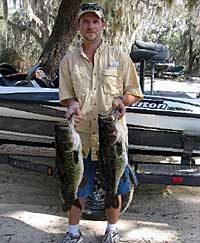
If the beginner’s cast and series of increasingly longer twitches doesn’t result in a strike within 5 or 6 feet, Barry suggests “Reel it up and maybe make one more cast, and then move on.”
Why Props?
Some curious anglers may ask, “If you move it that slow, then why in the world do you need a propbait?” Barry agrees it is a great question to which he has only one answer, “I’ve caught so many more fish on that Devil’s Horse, (for only God knows what reason). I don’t know if it is the props, or the color, or the size, maybe it imitates an injured minnow better than other types, (such as poppers, etc...). All I know is I have done amazingly well using the Devil’s Horse – so now it is my ‘go to’ bait as far as topwater goes.”
Rod Angle
Rod angle plays an important role in this technique. “If the pads are on my left from where I cast,” says Barry, “my rod is going to be down and I’m pulling to the right. Not up. That way the propbait is moving away from the pads, grass, or pilings I cast at without getting hung up.”
The Bite is On or Its Not!
Barry never wastes time changing out colors or fine tuning size, believing that either the Devil’s Horse ‘bite’ is on, or it’s not. “You’ll either get bit or you won’t. It’s always like that. Topwater here is very sporadic, although some days they’re just busting everywhere, and it’s a great time for topwater.”
A Bait of Last Resort
Many anglers see topwater as something that only works when the fish are extremely active. But that has not always been Barry’s experience. “I fished a tournament where my partner and I tried crankbaits, worms, and everything else, and nothing worked for us. And then we said, ‘What the heck, let’s try a Devil’s Horse.’”
“The first cast resulted in a 4 pounder. And we continued along the whole bank, (and it was overcast and windy, a day when you would not believe a topwater bait would work), and we wore the fish out. We caught our limit three times on the Devil’s Horse and won the tournament.” The Devil’s Horse can actually be a bait of last resort.
The Blow Up!
When teaching the Devil’s Horse technique to beginners, Barry says, “Before they even cast, I’m going to tell them that if they see something blow up on that topwater - don’t do anything. It has 9 hooks in it! Chances are you aren’t going to pull it out of their mouth but… I still want them to wait two seconds before they do anything. And then set the hook.”
Feel The Fish!
With any new angler in the boat, Weaver advises, “Wait until you feel the fish.” Naturally the surrounding structure and cover may put some limitations on how long an angler waits – after all, it doesn’t take long before a big bass can be heading right into the thickest jungle. Obviously in more open water, an angler can (and should) wait until they feel the fish before they set the hook. But the surrounding cover and structure will often determine the wait time before setting the hook.
Bass Bumping
It is also important to remember that bass will often just bump a topwater with its mouth closed. “I don’t know how they do it,” laughs Barry, “they must have some school down there to teach them how to miss a Devil’s Horse, because they can hit it and not touch the hooks. And you will see them swim two feet away, and come back to watch it again.”
“That’s when that twitch comes in handy. When the bass comes up and hits it but misses, …let the bait sit there. You don’t want to reel it back to the boat or move it real fast, just let it rest there for a second. Why? Because the bass is just sitting there looking at it, perhaps wondering ‘Hey, are you going to move again?’ And when you twitch it a second time, he’ll come back and bust it.”
The Hook Set
When it IS time to set the hook, Barry says, “Usually I use a sweeping hookset to the side. If you are doing it right and waiting until you feel the fish, there is no need to do a Bill Dance ‘Cross-their-eyes’ hookset. Just a quick jerk is all you need to get those hooks embedded.”
“Like I said, there are 9 hooks, and it's easy for a bass to inhale the whole bait. Very rarely do you get just one hook in his lip. Typically you get all three hooks right in his mouth. The bass will often come at it sideways, and you will get the front hook on one side of his mouth and the tail hook in the other side, and the middle one is attached to one of the lips.”
Fighting the Fish!
When it comes to fighting a shallow cover bass, Barry says, “I like to keep the rod tip low, almost in the water. I’ve had them get off before and that usually happens when they are leaping out of the water too much. So I try to keep that rod tip low and keep them from jumping. I want to keep them coming to the boat nice and steady until they get close enough to net them.”
Why Did I Lose It?
Beginners often complain of losing too many fish with a topwater, but Barry suggests it is because they are “Working it too fast. Or setting the hook before the fish has it. A lot of people see something blow up on their bait and set the hook immediately. It’s the same thing they do when fishing plastic frogs on the surface; they see something hit it and they set the hook too early. You need that second or two to know that the bass is on before you do anything.”
Numbers or Monsters?
Some baits get known for catching numbers of bass and others for catching large fish. Which is the Devil’s Horse? “I’d say both, about 50-50. Many times I’ve caught 8 and 9 pounders on a Devil’s Horse, and sometimes… a 12 inch fish.” Then Barry laughed, “I have even caught bluegill on it. Crazy.”
Boat Control
Proper boat handling plays an important role when throwing the Devil’s Horse along the shoreline, weed edges, or lily pads. “If I am fishing the shoreline, I am paralleling it. And like I said, you don’t want too much wind while you are cruising down the river or lake. You want just a little bit so you can keep moving slowly, because you are not working that bait very fast.”
“So you want to keep the boat going parallel with the shore, (not too close, just far enough for a cast – 20 or 30 yards or so), and just far enough away so you are not spooking the fish. Work every little indent or hole in the weeds or pads, and just keep moving.”
Maybe More Than One
“As soon as you find fish, remember; just because you caught one fish doesn’t mean it is over. Sometimes those fish are battling over that Devil’s Horse. I’ve seen two or three fish come at it at once. A couple of more casts in the same spot isn’t a bad thing. Just work that area. You don’t have to throw right back in that same spot, but if you caught one up in the cut, come back and fish the two points at the end of the cut. Fish that area real well before you move on.”
Locate First, Then Topwater
It’s important when fishing lakes that are filled with thousands of acres of lily pads or weeds to remember that the majority of fish may be concentrated in only a few small areas. In other words, not all the billions of lily pads hold fish.
That’s why on new water, Barry often uses fast moving lipless crankbaits to cover water and locate the concentrations of fish. Only then, will he switch over to the Devil’s Horse, recognizing that success often comes from “…being in the right spot at the right time.”
Hydrilla Holes!
In Florida, there is one time of the year when the propbaits are incredibly effective and it has to do with the growth of the aquatic vegetation called Hydrilla. “In our part of the country we have hydrilla everywhere. And when hydrilla is almost topped out, just 2 inches from the surface, you can see holes in it. I look for those spots.”

“When I see a patch of hydrilla with a 10 foot hole in the middle of it; I know that’s prime topwater territory. You can work the bait over the hole without getting all tangled in it. Usually I’ll let it sit there, and I will do my couple of twitches, and the bass will bust it right there above the hole.”
SLOW, SLOW, SLOW!
Barry’s final advice for anyone wanting to master the Devil’s Horse: “Slow it down! A lot of guys just go out there and crank it back, throw it again, and repeat this until frustrated. Or they tend to jerk it really hard to get the propellers moving. But don’t worry about the splash and propellers, just work it real slow.”
Next time you are on the lake and see a dying baitfish on the surface, Barry suggests watching it closely – because that is what a Devil’s Horse should look like. “Usually,” says Barry, “it’s floating near the surface and it’s just twitching. That forage is just barely moving, I want that Devil’s Horse to look just like that.”
Rediscover A Winner!
Over the 60 plus years the Devil’s horse propbait has been around, it has been responsible for countless numbers of bass. Unfortunately, (except for Florida), today’s younger anglers have been distracted by the latest fads in lures. It may well be time for the propbait to be “re-discovered again!”

Recognizing that bass often get conditioned to certain baits over time, (especially in heavily pressure lakes), a wise angler may be thinking, “You know, I’ve got to try the Devil’s Horse because no one else is throwing them around here, and this might be something the fish haven’t seen before”.
Fish It PROP’rly!
Whether you throw a standard Devil’s Horse off the shelf, or one with a custom paint job, understand – a lure doesn’t sell for 60 plus years unless it has the ability to catch fish. But in this “go fast world” it is important to resist “ripping” the bait and instead, present the topwater lure properly. Twitch it - like a dying bait fish.
Let the prop on your main boat engine hit the high RPM's, but when it comes to the props on the Devil Horse; go slow – fish it southern style!
In PART I - Barry Weaver explained why the classic Devil's Horse propbait is his "go to" topwater bait. He explained the right lake and weather conditions, and the proper equipment necessary to throw this topwater bait. His favorite size and color was described in detail.
---------------------------------------------------------------------------------------------------------------------
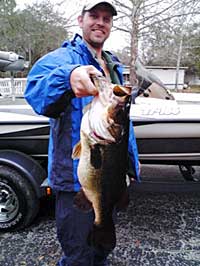
Barry Weaverhas been a successful Florida bass tournament angler and was the owner of "The Crankin' Cracker" - a custom painted crankbait shop. He is now retired from the fishing industry, and residing in Silver Springs, Florida.


